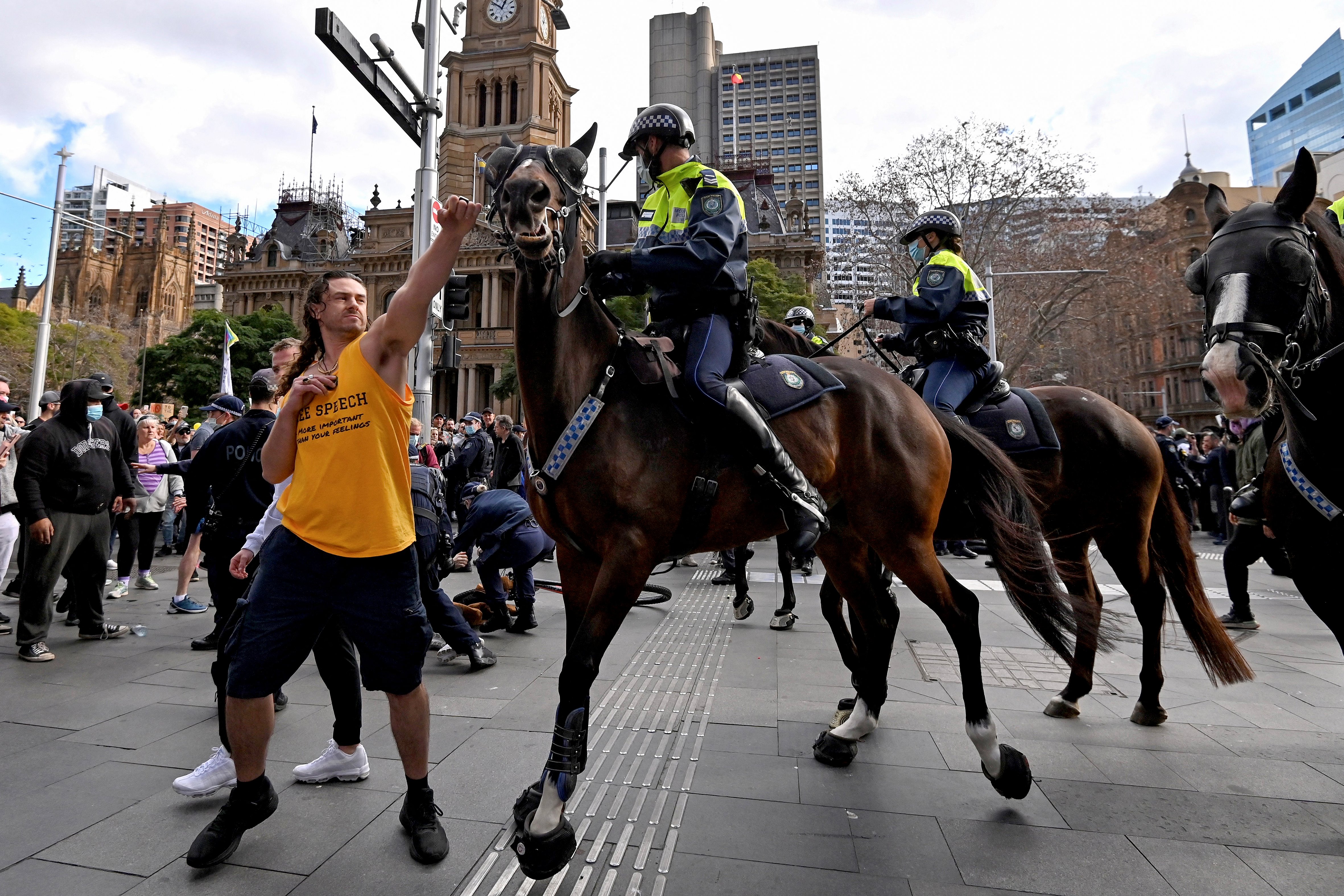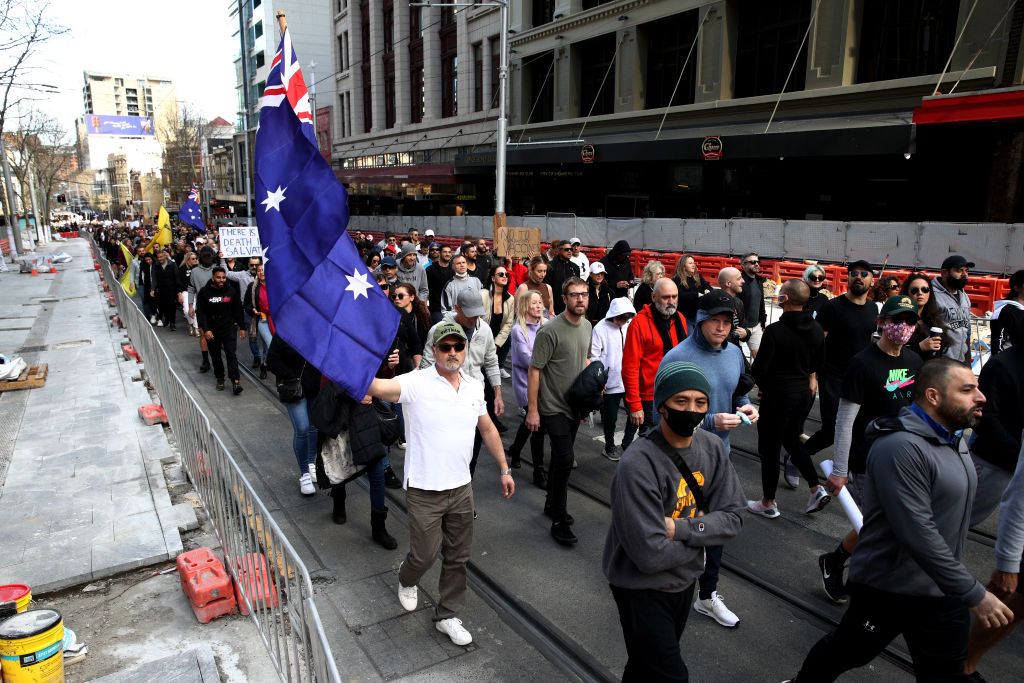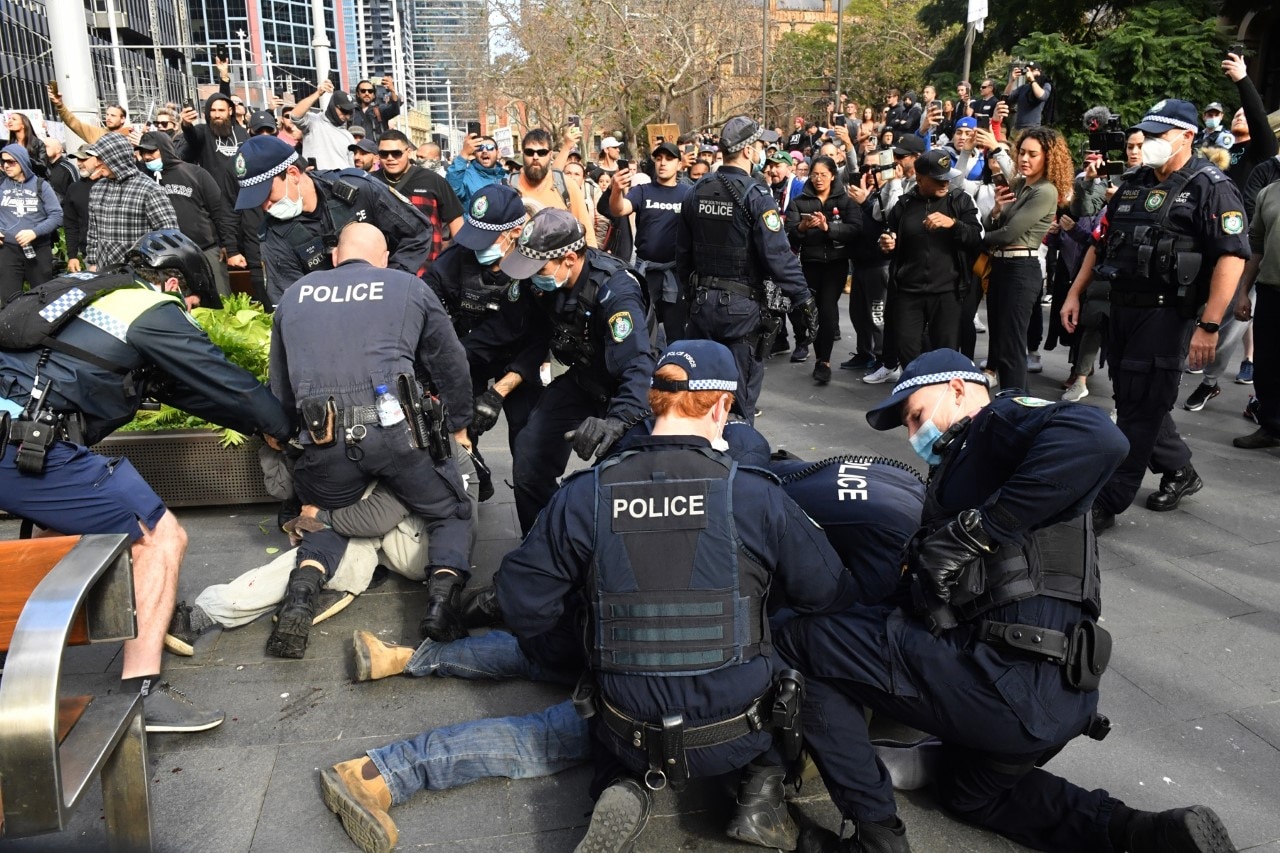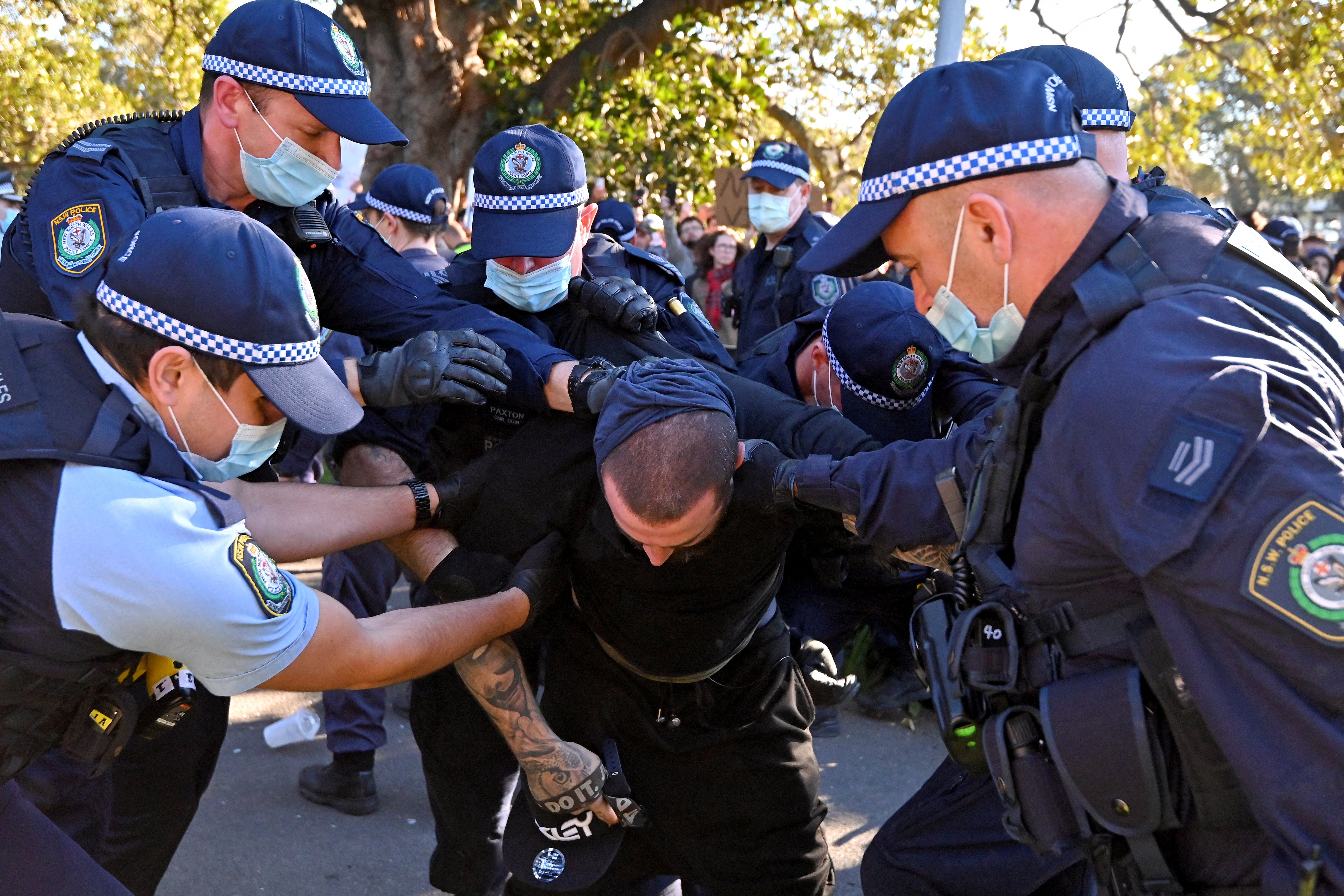Experts say a growing frustration with the government’s handling of the COVID-19 pandemic was a key factor that led thousands of people to partake in illegal anti-lockdown protests around Australia.
More protests are planned for this weekend in Sydney, with NSW Police warning the events will be “heavily policed” and “that behaviour will not be tolerated again”.
While police have vowed to crack down, experts say this alone won’t be enough to curb deeper issues of growing frustration, influence from far-right groups and the growth of unregulated communication channels.
Protests reveal ‘a more deep-seated problem’
Politicians around the country condemned the protests, with Prime Minister Scott Morrison labelling it a “very selfish act”.
“It will only risk the lockdowns running further,” he said on Sunday, accusing those who attend Sydney’s protest of “putting themselves at risk, those around them at risk, particularly the police at risk”.
NSW Premier Gladys Berejiklian said the protest “broke her heart”, and released a statement saying she was "utterly disgusted" by those who had shown "utter contempt for their fellow citizens".
"This type of activity during lockdown will not be tolerated and the full force of the law will be brought against anyone who engages in this type of illegal activity," she said on Sunday.
Dr Timothy Graham, a senior lecturer on social media analysis at the Queensland University of Technology, noted the general public took an “overwhelmingly negative and critical” view of the protests when they unfolded.
“On the day, it was like Twitter erupted. The vast majority of people tweeting about it were critical of it, and all these controversies came out of it on the day - such as the [alleged] horse-punching incident," he told SBS News.
Dr Josh Roose, Senior Research Fellow at Deakin University, said that while the protests were frustrating to watch, they were symptomatic of a much deeper problem with Australia’s overall response to the COVID-19 pandemic.
“It’s easy to ostracise and make fun of the protesters. Of course we’re all angry about [the protest],” he told SBS News.
“But the fact that this is emerging, and it’s so new, and taking on brand new forms, indicates a much deeper-seated problem around trust, around engagement with communities and around people who feel alienated and disempowered.”
Dr Roose said a “real lack of political leadership across the board” arguably contributed to the demonstrations, and had some influence on the various groups that showed up.
“The communication around the vaccines has created a perfect storm for anti-vaxxers. The complete contradiction of public health officials across the states, political point-scoring, and lack of consistent messaging has created a perfect storm for anti-vaxxers and other conspiracy theorists to exploit," Dr Roose said.
“[Protesters] are saying, well, one side is saying this, the other side is saying that, and they’re all lying, and they grow their movement through that.
“There’s got to be consistent bipartisan political messaging in the national interest.”
Dr Roose said politicians needed to acknowledge and improve on failures in their COVID-19 communication going forward
Diverse groups 'united under the same concern'
The anti-lockdown protests were amplified through apps like Facebook, Instagram and Telegram, before growing into a more coordinated movement.
While this narrative echoes far-right rallies that have taken place around the world, including parts of Australia, experts said the anti-lockdown protests were "fundamentally different" in that they united seemingly polar-opposite groups.
“Every group there had their own interest, and their own particular angle on the protest,” Dr Graham said.
“The conspiracy far-right elements were much more concerned with the government and media trying to control them.
“Then you had the wellness groups who are also concerned with individual liberty and freedom, and distrust in the medical industry … they had this perception that this is the latest government imposition on their bodies.
“Then you had people who were weaponising the protest to push their agenda of defunding the ABC.
“They took up all these different banners, and have different views, but somehow they’re all united under the same concern.”
He also noted a strong economic aspect to the protests. “There’s quite a number of people who, beyond the political, beyond the gender issues, are just concerned with their own economic well-being - they own businesses, they’ve seen 90 per cent of their clientele disappear, and they feel they’re not getting the government support they need.”
Dr Roose stressed that not everyone who attended the protests was from a fringe group - many were just frustrated Sydney residents.
“You’ve got to acknowledge, from the outset, that they’re highly multicultural. There’s also a strong representation of women, as well as everything from anti-vaxxers to 5G activists, conspiracy movements, sovereign citizens, libertarians and so on," he said.
“But there’s also people from backgrounds where there’s a distrust of government embedded into the culture of many of these groups, because that’s where they’ve come from.”
In Sydney’s case, Dr Roose said the areas of the residents who came out to protest were also significant.
“They are from communities that have been hardest-hit by COVID. People who work in precarious sectors of the economy, those who were first to lose their jobs as casuals, small businesses,” he said.
“They feel like their communities are being targeted, much more-so than, say, the eastern suburbs of Sydney.”
The conspiracy theorists and far-right groups, Dr Roose explained, were an "overlap", and took influence from far-right movements around the world.
“The language that’s used is often borrowed directly or appropriated directly from Donald Trump and the American right. They’re talking about freedoms, liberties, flying the flag upside-down. And there are far-right figures attempting to mobilise these movements as well.”
He said these various groups were united by a shared sense of dissatisfaction with the government.
“There’s a sense of alienation from these individuals and groups and movements, and also a strong sense of self-righteousness. They believe that what they’re doing is standing up to authority, fighting for ‘real Australia’, and in many ways that closely parallels the far-right.”
Dr Kristy Campion, Lecturer of Terrorism Studies with the Australian Graduate School of Policing and Security, said that some of the signage displayed indicated that not all attendees were there to voice their frustrations with the vaccine rollout.
“While discontent with government management and the vaccine rollout is not unfounded, I would argue that some of the signage displayed at the protest indicated that perhaps attendees would not have taken the vaccines anyway,” she told SBS News.
Rather, these attendees were likely there to express their opposition to the status quo.
“If individuals are deeply immersed in conspiratorial or ideological world views, there is potentiality that they will interpret government communication is an ideologically-significant way," she said.
“For some, this means that anything which seems to compromise their way of life will be rejected and opposed outright.”
How social media exacerbated the problem
Experts said further fuelling such movements is the lack of adequate government handling of misinformation on popular social media networks.
“Governments have found themselves unable to adequately hold social media to account for their role in facilitating these communications,” Dr Roose said. “There has been an attempt by social media to ban these groups when they pop up, but you could argue they’re not as productive as they could be.”
He also said the method of communicating, and organising such movements, has shifted over the years onto unregulated or less regulated platforms.
“Things have shifted, where rather than using Twitter, Facebook or other platforms, they’re moving onto encrypted messaging apps, which serve as live message boards.”
Dr Campion said Telegram’s anonymity was a key factor in such protest movements.
“One of the reasons Telegram is so popular, and able to harness such numbers, is due to a couple of features: anonymity, channels, and platforming,” she said.
“These functions allow users to anonymously (or publicly) put content online and disperse it across a number of channels where it is shared and re-shared and unlikely to be de-platformed. Its expansion to open social media only enhanced the reach from there.”
She said social media, whether encrypted or not, can provide the “connective tissue” for these groups and ideas, and ultimately the organisation of such events.
“In times of crisis, people seek comfort in secure – and often simplistic – understandings of the world," Dr Campion said.
"Misinformed explanations cut through complexity and provide simple – and often wildly inaccurate or non-scientifically-based – ideas about exactly what’s going on, and as a result, they can get quite conspiratorial.
“The COVID-19 environment has exposed the fact that misinformation can be both crowd-sourced or led by public figures, and that social media can be a vector for exposure.”
Dr Graham said social media networks ultimately enable these seemingly opposite groups to come together.
“What’s really interesting about the role of social media is how it enabled what would otherwise be distinct communities - QAnon conspiracy groups, far-right political activists, but also anti-vaxxers, female business owners at the fringe of the wellness movement, and those who have a ‘left-wing’ ideological points of view," he said.
“They would disagree almost fundamentally on any policy issue, but somehow, they were able to come together under the marriage of this banner of choice and freedom, and distrust in the media and bureaucracy.
“Even though you can’t blame [social media], because many of these issues are long-standing issues, and very old ideas. But social media enables them to find a way to unite.”
Dr Roose said anonymous messaging apps in particular should be a focus area for the government.
“If anything, you’d want to now, as the government, be looking at these encrypted messaging apps, which opens up a whole can of worms in terms of privacy and freedom as well.”
What will happen this weekend?
Further anti-lockdown protests have been planned for this weekend, but authorities have warned there will be a heavy police presence.
"There are some discussions, there is information on the Internet at the moment about a potential protest this Saturday," NSW Police Commissioner Mick Fuller said on Monday.
"We will be heavily policing that event. We will take the ground very early. You will be arrested and prosecuted."
Dr Graham said there is likely to be more "awareness" and perception of risk this time around.
"I think there’s still some uncertainty about what police action is going to take place for those involved," Dr Graham said.
"One thing we didn’t foresee was that there was a lot of, almost doxxing, going on during the protests. I think now there’s a bit more of an awareness and a perception about the risk to privacy, and things like that.
"I’d say the mobilisation carries more of a risk calculus to it now, and I think it will still hinge a bit on what the outcomes are with police interest, because the police are very aware that this is happening and it was out in the open."
Dr Roose said it can be expected that police will be a lot more prepared this weekend, and “potentially more rigorous”.
“In the history of protests, that can go one of two ways. There might be more people attracted because of the perceived success of the last models," he said.
“Or, alternatively, less people go, and you see more violent scenes - police and protesters clash.
“Either way, I wouldn’t expect to see a complete repeat of what we saw last weekend.”
https://news.google.com/__i/rss/rd/articles/CBMieWh0dHBzOi8vd3d3LnNicy5jb20uYXUvbmV3cy9leHBlcnRzLXNheS1hbnRpLWxvY2tkb3duLXByb3Rlc3RzLXJldmVhbC1hLW11Y2gtZGVlcGVyLXNlYXRlZC1wcm9ibGVtLWluLWF1c3RyYWxpYS1yaWdodC1ub3fSAaoBaHR0cHM6Ly9hbXAuc2JzLmNvbS5hdS9lZHMvbmV3cy9hcnRpY2xlL2V4cGVydHMtc2F5LWFudGktbG9ja2Rvd24tcHJvdGVzdHMtcmV2ZWFsLWEtbXVjaC1kZWVwZXItc2VhdGVkLXByb2JsZW0taW4tYXVzdHJhbGlhLXJpZ2h0LW5vdy84YzkyMjk1NC0wZjkyLTQ3ZmUtYTQ5Yy03ZGQ0YWVmNGJmOWE?oc=5
2021-07-28 10:32:45Z
52781756518704
Bagikan Berita Ini


















0 Response to "Experts say anti-lockdown protests reveal a ‘much deeper-seated problem’ in Australia right now - SBS News"
Post a Comment